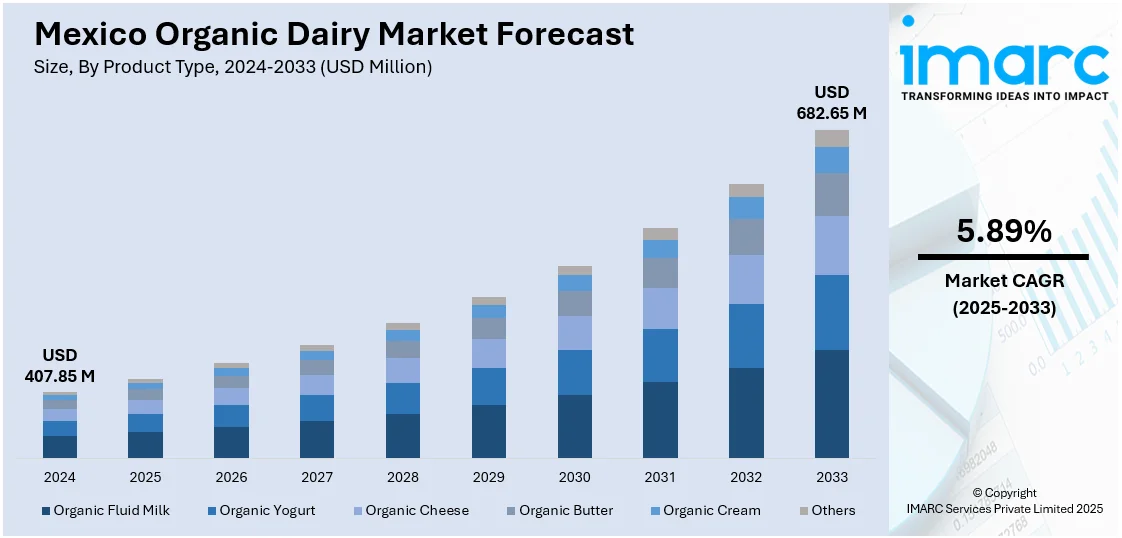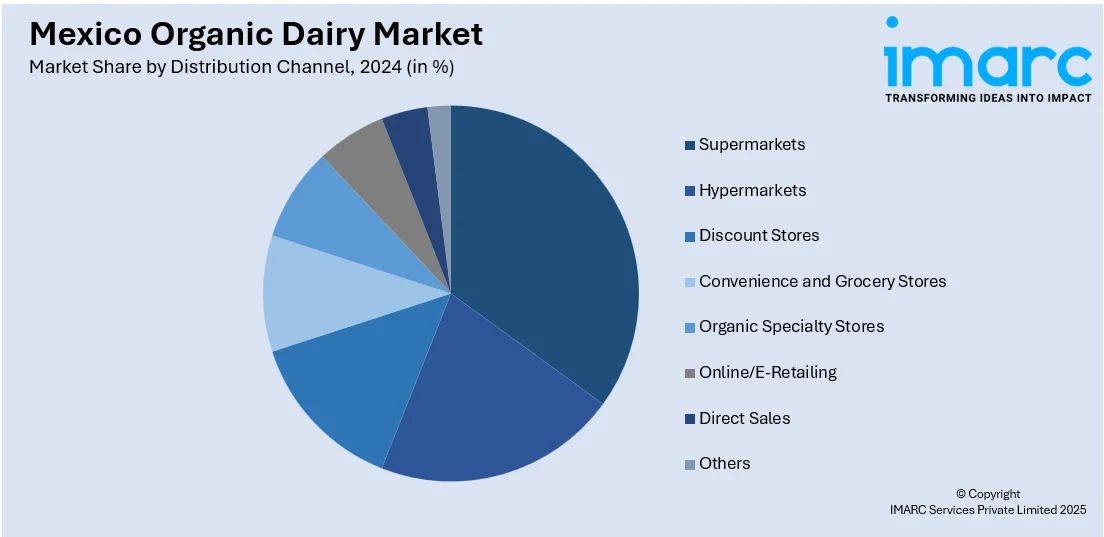
Mexico Organic Dairy Market Size, Share, Trends and Forecast by Product Type, Packaging Type, Distribution Channel, and Region, 2025-2033
Mexico Organic Dairy Market Overview:
The Mexico organic dairy market size reached USD 407.85 Million in 2024. Looking forward, IMARC Group expects the market to reach USD 682.65 Million by 2033, exhibiting a growth rate (CAGR) of 5.89% during 2025-2033. The market is driven by increasing health consciousness, rising disposable incomes, expanding urbanization, and growing preference for clean-label products. Consumers seek natural and sustainable food options, supporting local farmers and businesses.
|
Report Attribute
|
Key Statistics
|
|---|---|
|
Base Year
|
2024 |
|
Forecast Years
|
2025-2033
|
|
Historical Years
|
2019-2024
|
| Market Size in 2024 | USD 407.85 Million |
| Market Forecast in 2033 | USD 682.65 Million |
| Market Growth Rate 2025-2033 | 5.89% |
Mexico Organic Dairy Market Trends:
Health and Wellness Awareness
The growing health consciousness among Mexican consumers is a key factor driving demand for organic dairy products. These items are free from synthetic hormones, antibiotics, and pesticides, making them attractive to those seeking cleaner, more natural food options. Rising cases of obesity, diabetes, and food allergies have led families to reconsider their dietary choices, which is fueling the Mexico organic dairy market share. As a result, organic milk, yogurt, and cheese are gaining popularity for their perceived nutritional benefits. People in both the Millennial and Gen Z generations show active behavior through label reading to find health-promoting ingredients, including probiotics and Omega-3s. The push for nutritious eating and better awareness about the value of organic food has received extra support through public health education campaigns.

Environmental Sustainability Concerns
Environmental concerns are significantly shaping consumer preferences in Mexico, especially in urban and educated populations. Organic dairy farming supports sustainability by avoiding chemical inputs, reducing water pollution, and encouraging biodiversity. Consumers increasingly favor products aligned with responsible agricultural practices and animal welfare. Labels like “organic” and “free-range” offer reassurance, prompting many to choose these over conventional options. Climate change awareness and global sustainability trends have also influenced purchasing behavior, thereby creating a positive impact on the Mexico organic dairy market outlook. Brands are responding by highlighting their eco-friendly practices in marketing and packaging. As more people connect food choices to environmental impact, organic dairy stands out as a meaningful way to reduce ecological footprints—helping drive consistent demand across various regions of the country.
Rising Disposable Income and Urbanization
Mexico’s rising middle class and increased urbanization are fueling growth in the organic dairy market. Higher disposable incomes allow consumers to prioritize premium food options, including organic dairy, which typically commands a higher price. In urban centers, access to supermarkets, organic stores, and e-commerce platforms has made these products more available and visible. Urban lifestyles are also more health-focused and trend-driven, encouraging interest in wellness-oriented food, thus driving the Mexico organic dairy market growth. Exposure to international food trends, nutritional education, and clean-label preferences is strongest in cities, where most of the demand originates. As more consumers gain purchasing power and convenience becomes a priority, the organic dairy sector is expected to continue expanding steadily.
Mexico Organic Dairy Market Segmentation:
IMARC Group provides an analysis of the key trends in each segment of the market, along with forecasts at the regional level for 2025-2033. Our report has categorized the market based on product type, packaging type, and distribution channel.
Product Type Insights:
- Organic Fluid Milk
- Organic Yogurt
- Organic Cheese
- Organic Butter
- Organic Cream
- Others
The report has provided a detailed breakup and analysis of the market based on the product type. This includes organic fluid milk, organic yogurt, organic cheese, organic butter, organic cream, and others.
Packaging Type Insights:
- Pouches
- Tetra-packs
- Bottles
- Cans
- Others
A detailed breakup and analysis of the market based on the packaging type have also been provided in the report. This includes pouches, tetra-packs, bottles, cans, and others.
Distribution Channel Insights:

- Supermarkets
- Hypermarkets
- Discount Stores
- Convenience and Grocery Stores
- Organic Specialty Stores
- Online/E-Retailing
- Direct Sales
- Others
A detailed breakup and analysis of the market based on distribution channel have also been provided in the report. This includes supermarkets, hypermarkets, discount stores, convenience and grocery stores, organic specialty stores, online/e-retailing, direct sales, and others.
Regional Insights:
- Northern Mexico
- Central Mexico
- Southern Mexico
- Others
The report has also provided a comprehensive analysis of all the major regional markets, which include Northern Mexico, Central Mexico, Southern Mexico, and others.
Competitive Landscape:
The market research report has also provided a comprehensive analysis of the competitive landscape. Competitive analysis such as market structure, key player positioning, top winning strategies, competitive dashboard, and company evaluation quadrant has been covered in the report. Also, detailed profiles of all major companies have been provided.
Mexico Organic Dairy Market Report Coverage:
| Report Features | Details |
|---|---|
| Base Year of the Analysis | 2024 |
| Historical Period | 2019-2024 |
| Forecast Period | 2025-2033 |
| Units | Million USD |
| Scope of the Report | Exploration of Historical Trends and Market Outlook, Industry Catalysts and Challenges, Segment-Wise Historical and Future Market Assessment:
|
| Product Types Covered | Fluids Milk, Yogurt, Cheese, Butter, Cream, Others |
| Packaging Types Covered | Pouches, Tetra-Packs, Bottles, Cans, Others |
| Distribution Channels Covered | Supermarkets, Hypermarkets, Discount Stores, Convenience and Grocery Stores, Organic Specialty Stores, Online/E-Retailing, Direct Sales, Others |
| Regions Covered | Northern Mexico, Central Mexico, Southern Mexico, Others |
| Customization Scope | 10% Free Customization |
| Post-Sale Analyst Support | 10-12 Weeks |
| Delivery Format | PDF and Excel through Email (We can also provide the editable version of the report in PPT/Word format on special request) |
Key Questions Answered in This Report:
- How has the Mexico organic dairy market performed so far and how will it perform in the coming years?
- What is the breakup of the Mexico organic dairy market on the basis of product type?
- What is the breakup of the Mexico organic dairy market on the basis of packaging type?
- What is the breakup of the Mexico organic dairy market on the basis of distribution channel?
- What is the breakup of the Mexico organic dairy market on the basis of region?
- What are the various stages in the value chain of the Mexico organic dairy market?
- What are the key driving factors and challenges in the Mexico organic dairy market?
- What is the structure of the Mexico organic dairy market and who are the key players?
- What is the degree of competition in the Mexico organic dairy market?
Key Benefits for Stakeholders:
- IMARC’s industry report offers a comprehensive quantitative analysis of various market segments, historical and current market trends, market forecasts, and dynamics of the Mexico organic dairy market from 2019-2033.
- The research report provides the latest information on the market drivers, challenges, and opportunities in the Mexico organic dairy market.
- Porter's five forces analysis assist stakeholders in assessing the impact of new entrants, competitive rivalry, supplier power, buyer power, and the threat of substitution. It helps stakeholders to analyze the level of competition within the Mexico organic dairy industry and its attractiveness.
- Competitive landscape allows stakeholders to understand their competitive environment and provides an insight into the current positions of key players in the market.
Need more help?
- Speak to our experienced analysts for insights on the current market scenarios.
- Include additional segments and countries to customize the report as per your requirement.
- Gain an unparalleled competitive advantage in your domain by understanding how to utilize the report and positively impacting your operations and revenue.
- For further assistance, please connect with our analysts.
 Request Customization
Request Customization
 Speak to an Analyst
Speak to an Analyst
 Request Brochure
Request Brochure
 Inquire Before Buying
Inquire Before Buying




.webp)




.webp)












